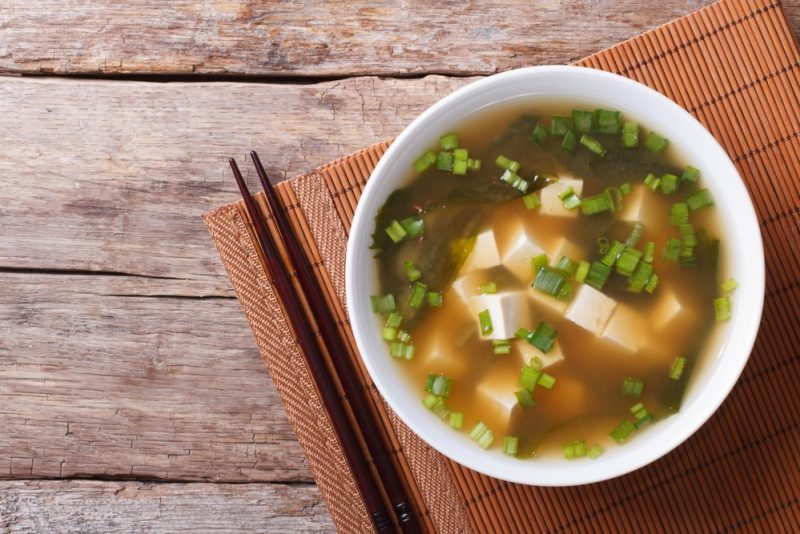Miso Soup is a traditional soup from Japan that is considered a staple in the local diet of the country. It is often consumed daily by the Japanese due to its health benefits as a probiotic. A lot of families will make their own miso soup at home but it is also commonly available in restaurants all over Japan too.
Due to its health benefits and the attraction of the unique Japanese cuisine, miso soup is becoming more popular and more available in many other countries around the world.
Is miso soup vegan? Even though it may sound like miso soup contains no meat, egg or dairy, traditionally it is NOT vegan.
The soup has two main ingredients; miso paste and dashi which is a Japanese-style stock. The miso paste is melted and gently mixed into the warm dashi to create a nourishing cloudy broth. Often it will then have tofu, seaweed, or other regional flavorings added to it.
This is due to the traditional dashi stock not being vegan. To give the stock a saltiness and umami flavor, it is seasoned with flakes of dried fermented fish; usually tuna or sardines.
This fermented fish is a common seasoning in Japanese cooking and tends to be ubiquitous across the traditional cuisine; used in a very similar way to salt. This makes vegan and vegetarian food often hard to find within traditional Japanese restaurants.
When ordering miso soup in restaurants, the stock is usually made ahead of time in big batches so more often than not you won’t be able to get the broth without the fish. However, it is always worth asking as due to veganism being more prevalent nowadays you might find the restaurant will have a vegan variety to offer you.
If making miso soup at home, you can simply substitute the dashi for your own preferred vegetable-flavored stock.
Despite the dashi not being vegan, the second ingredient, miso paste, however, is traditionally vegan as it derives from plant ingredients.
What is miso paste?
Miso paste is made by fermenting soybeans, rice, or barley and so is completely plant-based and vegan-friendly. You can get a wide variety of miso pastes made with all sorts of beans, pulses, and grains; especially now that it has reached the Western world, miso paste is being made with non-Japanese produce such as chickpeas and fava beans.
Regardless of the ingredients used, all miso pastes are made by a certain fermentation method that turns the beans and grains into an intensely flavored, thick paste.
Traditional miso paste is made by mashing up the soybeans and/or grains, mixing them with salt and a Japanese mould called koji. It is then left to ferment; depending on the intensity of the flavor desired it can be left to ferment from anywhere between a few months to a few years. As you can imagine, the longer the miso paste is left to ferment, the more intense the flavor becomes.
In Japan, the paste is mostly only used to make miso soup. However, nowadays in modern global cuisines it is used as a seasoning for a variety of dishes and brings more complexity and an umami characteristic to marinades, dressings, stocks, and seasonings.
As explained, miso paste is commonly completely vegan and vegetarian friendly. However, due to the nature of Japanese cuisine, when buying from the supermarket do always check the label to make sure.
What are the health benefits of miso soup?
Miso soup contains a range of healthy ingredients that when combined offer a wide variety of minerals and vitamins as well as a good balance of the macronutrients; protein, carbohydrates, and fat.
Being high in protein and essential amino acids as well as containing many essential minerals and vitamins such as vitamins B12, B2, K, and E, makes miso soup a great addition to a plant-based diet.
The combination of ingredients in the soup also makes it very alkaline meaning it can be very beneficial for re-balancing the body and strengthening the immune system. Due to the fermentation of the miso paste, the soup can also be drunk for its probiotic attributes which positively impacts gut health. Having a healthy gut can boost skin health as well as overall physical and mental wellbeing.
With all these nutritional benefits, it makes sense that Japanese people see miso soup as a healthy food that should be consumed daily. Adding miso soup to your daily diet, as a simple drink during the day or just before the main meal, could really boost and improve one’s health and wellbeing.
How to make miso soup vegan?
Defined earlier in this article, miso soup is traditionally made using miso paste and dashi broth. The dashi is what makes it unsuitable for vegans and vegetarians. However, there is a version of dashi broth that is made using shiitake mushrooms and/or kombu seaweed; both being plants and vegan-friendly.
If making miso soup at home, you can find a recipe for shiitake or kombu dashi online and if ordering miso soup in a restaurant, ask the waiters if they have this kind of dashi or if they make their own vegetarian or vegan-friendly dashi.
Now that miso soup is more globally available, it is also common to find it made with a more Western-style stock or broth rather than dashi. However, do still check any stock you buy-in
a supermarket or eat in a restaurant is vegan-friendly as any kind of stock may be flavored with bones from animals such as cows or chickens.
Can anything else be added to miso soup?
Traditionally miso soup may come as a plain broth but often sliced spring onions, seaweed pieces, and diced tofu are added to it. If making it at home, make the soup first and then add in the tofu and other elements to heat through just before eating.
Miso soup is often just consumed as a drink or a side dish to the main meal. So even though the soup may seem quite plain and simple, it is often accompanied by rice-based dishes topped with vegetables, meats, or eggs or even served as a starter course before sushi.
If made at home, miso soup can be a great addition to a healthy plant-based vegan diet. It is simple to make and can be easily adapted to suit your own dietary requirements.
The main thing to remember is when ordering it in restaurants to double-check the ingredients of soup and especially check what dashi is being used.
The fermented fish flakes are prevalent in Japanese cuisine and is so often used as a simple seasoning. However, as veganism becomes more and more popular it is getting easier to find vegan-friendly alternatives in Japanese and many other world cuisines.
Miso Soup Vegan Recipe
If you are wanting to make vegan miso soup at home, here is a quick and delicious recipe for you.
This recipe uses simple shiitake dashi but that can be replaced with a kombu version or just a vegetable stock.
Makes 4 small bowls.
For Shiitake Dashi: 40g dried shiitake mushrooms 1000ml / 4 cups water
For Miso Soup: 1000ml shiitake dashi (or alternative) 2 tbsp dried wakame seaweed, soaked in water for 5 minutes then drained 2 green onions, sliced 200g silken/soft tofu, cubed 80g / 5 tbsp miso paste
To make the shiitake dashi, add the dried mushrooms to 1 liter of cold water. Ideally, let it sit in a sealed container overnight; this produces a better flavor. To make a quicker version, soak the mushrooms in warm water for about 15 minutes instead.
Once they have finished soaking, drain the mushrooms from the liquid. You can add the leftover mushrooms to the miso soup or save them for another dish.
To make the miso soup, gently heat the dashi broth over low heat. Once warm, gently whisk in the miso paste. Do not let the soup boil as that will kill off any good probiotics in the miso paste.
Add in the tofu. Let the soup gently heat for another few minutes before spooning into serving bowls; making sure you evenly distribute the tofu.
Sprinkle over the rehydrated seaweed, some sliced green onion, and serve.


